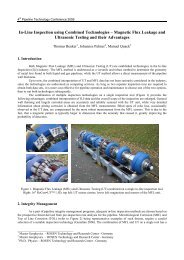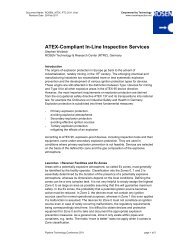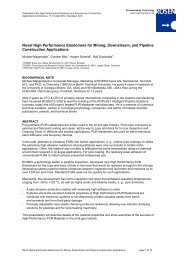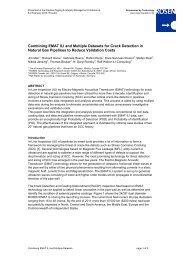View - ROSEN Inspection Technologies
View - ROSEN Inspection Technologies
View - ROSEN Inspection Technologies
Create successful ePaper yourself
Turn your PDF publications into a flip-book with our unique Google optimized e-Paper software.
Figure 3: Undersizing of dents as a function of coverage and<br />
number of caliper arms for a sharp dent with a tip angle<br />
a=120º. The maximum undersizing factor is a worst case<br />
scenario.<br />
MECHATRONIC SENSOR<br />
A disadvantage of the traditional mechanical caliper tool<br />
design, where the mechanical movement of the caliper is<br />
transformed into a position signal, is the dynamic behavior of<br />
the arms under run conditions. This typically leads to inspection<br />
speed restrictions. Above a critical tool speed, the caliper arm<br />
starts to lose continuous contact with the internal surface of the<br />
pipeline. But also at low speeds abrupt changes at the internal<br />
pipe surface may not be monitored correctly.<br />
Pure mechanical designs which try to overcome these<br />
problems have to be lightweight and hence are quite fragile.<br />
Therefore, these systems do not extend the operational range of<br />
this inspection task.<br />
Figure 4: Combination of conventional mechanical caliper<br />
concept(B) with a touchless operating proximity sensor (d).<br />
A solution for this problem is provided by a touchless<br />
measurement technology. To achieve high measurement<br />
accuracy and a satisfying circumferential resolution a<br />
mechanical caliper arm system equipped with a sensor to<br />
transform the mechanical movement into an electric signal and<br />
an electronic distance measurement were combined to a<br />
mechatronic solution.<br />
Figure 4 shows the touchless electronic sensor integrated<br />
inside the sensor head and a position sensor attached at the base<br />
of the sensor arm monitoring the mechanical position. The<br />
touchless electronic sensor is used to compensate data obtained<br />
from the dynamic behavior of the caliper arm. The unwanted<br />
effects of the caliper’s inertia is fully assimilated by the<br />
touchless measurement. Sharp transitions at the internal<br />
surface, such as a pipe misalignment at a girth weld, are<br />
monitored very well. Another example explains how the<br />
contour of a dent is monitored by the compensation method.<br />
Figure 5 shows the result simulated at 6.72mph (3 m/s).<br />
Figure 5: Compensated signal from a dent obtained with the by<br />
summation of the mechanical movement measurement and the<br />
touchless proximity signal.<br />
This example also emphasizes the tendency of oversizing<br />
the dent length by a pure mechanical caliper arm.<br />
Since the electronic sensor is insensitive to non-conductive<br />
material, the compensation method is always referring to the<br />
internal surface of the pipeline. Scale or wax debris, although<br />
detected by the system, will not affect the geometry evaluation<br />
of the pipeline.<br />
A single mechatronic unit is designed to cope with a toolspeed<br />
of up to 11.2 mph (5m/s) and to provide an accuracy of<br />
0.03” (0.8mm) for radial measurements.<br />
ANALYSIS FOR STATIC DENT STRAIN<br />
The accurate measurement of the dent geometry is the<br />
basis for a strain and subsequent stress analysis. For a static<br />
analysis of the stress in a dented area the bending strain at the<br />
material surface has to be known. With the strain stress curve<br />
the static stress at the dent surface can then be estimated. For an<br />
analysis of the strain in a dent area, the curvature of the dent<br />
surface has to be determined, because the strain at the surface is<br />
3 Copyright © 2006 by ASME







